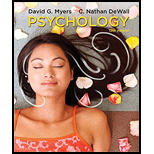
Introduction: Psychological drugs are the chemicals that are able of changing perceptions and moods of the person. The effect of this drugs overall depends upon the biological effects as well as the expectation of the user.
Answer to Problem 1MM
Correct answer: After continued use of a psychoactive drug, the drug user needs to take larger doses to get the desired effect. This is referred to as tolerance.
Explanation of Solution
Tolerance is the diminishing effect with regular use of a particular dose of a specific drug. Thus, there is a need for the user to take larger and larger doses of that drug before understanding its effect. Psychoactive drugs produce more tolerance to achieve the desired effect. Addiction to a specific psychoactive drug promotes the drug users to create a desire for the drug and to use it continuously. With the continuous use of the drug develops tolerance as their brain chemistry accepts to equalize the effect of the drug.
Want to see more full solutions like this?
Chapter 9 Solutions
Psychology in Modules
- Career counseling at the elementary level can help students in all the following ways except A. Making academic decisions during middle and high school B. Understanding interests, talents, and abilities C. Understanding the world or work and attitudes about work D. Assisting parents in becoming more involvedarrow_forwardDiscuss historically unethical studies (Little Albert, Milgram obedience study, Stanford prison study) and review the moral and ethical implications of these studies. Answer the following questions: What social ‘good’ was the study trying to explore or contribute to? What was the negative impact of their unethical methods? What were some of the moral reasoning used to justify this study?arrow_forwardWhich theoretical approach emphasizes modeling teaching, self-monitoring, contracting, and environmental restructuring A. Behavioral B. Cognitive Behavioral C. Reality therapy D. Solution Focusedarrow_forward
- Career counseling at the level can help students in all the following ways except A. Making academic decisions during middle and high school B. Understanding interests, talents, and abilities C. Understanding the world or work and attitudes about work D. Assisting parents in becoming more involvedarrow_forwardAn Appropriate strategy for helping children and families include all of the following except A.Therapy in school B.Legal and social services C.Long-term outpatient services D. Brief interventionsarrow_forwardWhich of the following are strategies included in the Ready to Learn Program A. Student story telling and retelling B. Student story retelling C. story telling D. Trackingarrow_forward
- Discuss historically unethical studies (Little Albert, Milgram obedience study, Stanford prison study) and review the moral and ethical implications of these studies. Answer the following questions: What social ‘good’ was the study trying to explore or contribute to? What was the negative impact of their unethical methods? What were some of the moral reasoning used to justify this study?arrow_forwardExamples from the book the great gatsby that show wealth is a social status and not a identityarrow_forwardResults : Correlation Pearson's Partial Correlations Variable JWB average IRMA total 2 1. JWB average Pearson's r — p-value — 2. IRMA total 2 Pearson's r 0.597 — p-value < .001 — Note. Conditioned on variables: Gen ID. Linear Regression Model Summary - IRMA total Model R R² Adjusted R² RMSE M₀ 0.000 0.000 0.000 5.450 M₁ 0.779 0.607 0.560 3.614 Note. M₁ includes Hostle Average, Gen ID, JWB average ANOVA Model Sum of Squares df Mean Square F p M₁ Regression 505.296 3 168.432 12.897 < .001 Residual 326.497 25 13.060 Total 831.793 28 Note. M₁ includes Hostle Average, Gen ID, JWB average Note. The intercept model is omitted, as no meaningful information can be shown. Coefficients Model Unstandardized…arrow_forward
- Questions #22,28,44,66; explain your answers throughly; give examples if you want 22) Which of the following represents a leading question?a. "What is your opinion of the recent policy change?"b. "Do you agree that the new policy is harmful?"c. "What is your age group: 18-25, 26-35, 36-50?"d. "Do you support the policy change?” 28) In a pretest-posttest design, which validity threat is most likely to occur?a. History effectsb. Random sampling errorc. Social desirability biasd. Observer effects 44) In a between-within factorial design, ____ IV is manipulated between subjects and ___ IV is manipulated within subjects. 66) What is the purpose of a reversal (ABA) design in single-subject research?a. To measure the effect of multiple treatments simultaneously.b. To establish causality by observing behavior before, during, and after treatment.c. To compare multiple participants’ behavior across conditions.d. To identify baseline differences between participants.arrow_forwardWhat does the results indicate? Correlation Pearson's Partial Correlations Variable JWB average IRMA total 2 1. JWB average Pearson's r — p-value — 2. IRMA total 2 Pearson's r 0.597 — p-value < .001 — Note. Conditioned on variables: Gen ID. Linear Regression Model Summary - IRMA total Model R R² Adjusted R² RMSE M₀ 0.000 0.000 0.000 5.450 M₁ 0.779 0.607 0.560 3.614 Note. M₁ includes Hostle Average, Gen ID, JWB average ANOVA Model Sum of Squares df Mean Square F p M₁ Regression 505.296 3 168.432 12.897 < .001 Residual 326.497 25 13.060 Total 831.793 28 Note. M₁ includes Hostle Average, Gen ID, JWB average Note. The intercept model is omitted, as no meaningful information can be shown. Coefficients Model…arrow_forwardHow has dogs became regular companions in our lives?arrow_forward
 Ciccarelli: Psychology_5 (5th Edition)PsychologyISBN:9780134477961Author:Saundra K. Ciccarelli, J. Noland WhitePublisher:PEARSON
Ciccarelli: Psychology_5 (5th Edition)PsychologyISBN:9780134477961Author:Saundra K. Ciccarelli, J. Noland WhitePublisher:PEARSON Cognitive PsychologyPsychologyISBN:9781337408271Author:Goldstein, E. Bruce.Publisher:Cengage Learning,
Cognitive PsychologyPsychologyISBN:9781337408271Author:Goldstein, E. Bruce.Publisher:Cengage Learning, Introduction to Psychology: Gateways to Mind and ...PsychologyISBN:9781337565691Author:Dennis Coon, John O. Mitterer, Tanya S. MartiniPublisher:Cengage Learning
Introduction to Psychology: Gateways to Mind and ...PsychologyISBN:9781337565691Author:Dennis Coon, John O. Mitterer, Tanya S. MartiniPublisher:Cengage Learning Psychology in Your Life (Second Edition)PsychologyISBN:9780393265156Author:Sarah Grison, Michael GazzanigaPublisher:W. W. Norton & Company
Psychology in Your Life (Second Edition)PsychologyISBN:9780393265156Author:Sarah Grison, Michael GazzanigaPublisher:W. W. Norton & Company Cognitive Psychology: Connecting Mind, Research a...PsychologyISBN:9781285763880Author:E. Bruce GoldsteinPublisher:Cengage Learning
Cognitive Psychology: Connecting Mind, Research a...PsychologyISBN:9781285763880Author:E. Bruce GoldsteinPublisher:Cengage Learning Theories of Personality (MindTap Course List)PsychologyISBN:9781305652958Author:Duane P. Schultz, Sydney Ellen SchultzPublisher:Cengage Learning
Theories of Personality (MindTap Course List)PsychologyISBN:9781305652958Author:Duane P. Schultz, Sydney Ellen SchultzPublisher:Cengage Learning





